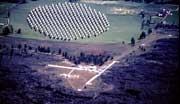Technologists
Allen and Myhrvold give SETI $12.5 million for revolutionary
new telescope
01
Aug 2000
Investor
and philanthropist Paul G. Allen and former Microsoft chief
technology officer Nathan P. Myhrvold will fund the development
phase of a new telescope at UC Berkeley that will be the world's
most powerful instrument designed to seek out signals from
civilizations elsewhere in our galaxy.
 Allen
will provide $11.5 million and Myhrvold $1.0 million for a
total gift of $12.5 million over three years. The announcement
was made Aug. 1 by the SETI Institute, the world's largest
private organization conducting research to determine whether
intelligent life exists beyond Earth. The institute is a nonprofit
organization based in California's Silicon Valley.
Allen
will provide $11.5 million and Myhrvold $1.0 million for a
total gift of $12.5 million over three years. The announcement
was made Aug. 1 by the SETI Institute, the world's largest
private organization conducting research to determine whether
intelligent life exists beyond Earth. The institute is a nonprofit
organization based in California's Silicon Valley.
The
announcement follows the April unveiling of the first prototype
of the telescope, which is being designed jointly by astronomers
and engineers at the SETI Institute and UC Berkeley. Announced
last year under a working title that described its 10,000-square-meter
collecting area - the One Hectare Telescope - the project
will be renamed the Allen Telescope Array.
"For
the first time in our history, we have the ability to pursue
a scientifically and technologically sophisticated search
for intelligent life beyond Earth at the same time we are
doing traditional radio astronomy," said Allen, a long-time
financial supporter of SETI and of scientific research in
a variety of fields. "This new telescope will be the world's
most powerful instrument for this search, and I am pleased
to support its important work."
 The
primary electronics laboratory to be built on site in support
of the Allen Telescope Array will be named for Myhrvold. A
longtime SETI advocate, Myhrvold was a member of the international
'blue ribbon' team of scientists and technologists engaged
in a two-year strategic planning effort in the late 1990s
from which the Allen Telescope Array concept emerged.
The
primary electronics laboratory to be built on site in support
of the Allen Telescope Array will be named for Myhrvold. A
longtime SETI advocate, Myhrvold was a member of the international
'blue ribbon' team of scientists and technologists engaged
in a two-year strategic planning effort in the late 1990s
from which the Allen Telescope Array concept emerged.
"The
Allen Telescope Array and associated laboratory are the latest
steps in our exploration of the cosmos," said Myhrvold. "While
the best scientific estimates tell us the probability of intelligent
life elsewhere in the universe is fairly high, there is great
uncertainty and some controversy in the calculation. One thing
however, is beyond dispute. That is, if we don't continue
supporting projects like the Allen Telescope Array, our chances
of discovery will remain at zero. While it's impossible to
predict exactly what we will find with a new scientific instrument,
we should remember that interesting science is not just about
the likelihood of end results -- it is also about the serendipity
that occurs along the way."
Links:
Full
SETI press release
SETI
Institute web site